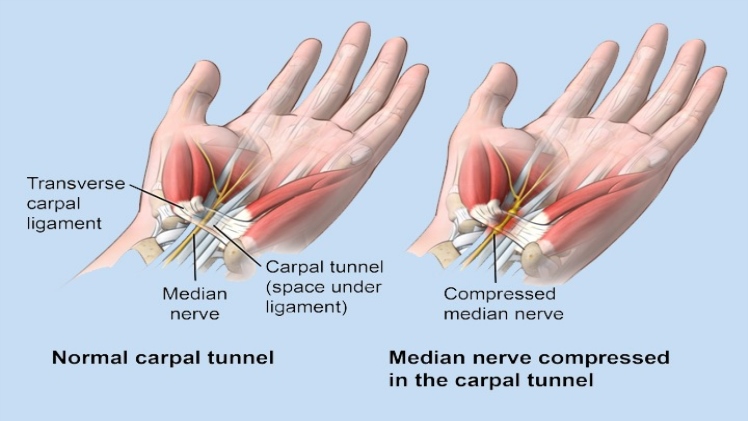The carpal tunnel is a narrow passage through the wrist formed by the carpal bones and carpal ligament. It is about an inch wide and has very rigid sides. The median nerve and flexor tendons pass through the carpal tunnel to reach the hand.
If the tunnel becomes narrowed or the tissue inside it becomes inflamed, it pinches the median nerve. This results in the hallmark symptoms of carpal tunnel syndrome, such as tingling, weakness, numbness, and pain. Physical therapy near me may help address many of these symptoms.
Causes of Carpal Tunnel Syndrome
Tightness within the carpal tunnel can be caused by several factors. The following are among the most common:
- Wrist positioning: Activities that position the wrist in an extended or flexed position for long periods can pinch the median nerve and cause carpal tunnel.
- Hormone fluctuations: Changes in hormones, such as during pregnancy, can increase swelling and pinch the median nerve.
- Repetitive use: Using the wrists in the same way over and over puts stress on the tendons and can cause repetitive use injuries including carpal tunnel syndrome.
- Genetics: Some people have smaller carpal tunnels than others naturally, which can increase the likelihood of pinched nerves or tendons.
Additionally, having existing health conditions, such as diabetes or arthritis, increases your chances of developing carpal tunnel syndrome.
Medication That Can Help Carpal Tunnel
Several medications can help reduce the severity of your symptoms. Many healthcare providers will recommend starting with a course of Nonsteroidal anti-inflammatory drugs to relieve pain. NSAIDS including naproxen and ibuprofen are often effective for short-term symptom management in mild carpal tunnel cases.
Steroid injections are a medication option for longer-term symptom management. Your doctor will inject a corticosteroid directly into the carpal tunnel, sometimes using ultrasound to guide the delivery. This provides targeted relief of pain and swelling.
How A Physical Therapist Can Help
Physical therapy Temecula can help relieve symptoms and reduce the strain you put on your wrist. A physical therapist will work with you to develop a program that accommodates your symptoms and lifestyle. This may include:
- Providing exercises to strengthen muscles around your wrist that become weak without regular use.
- Using gentle techniques to help reduce inflammation in the wrist. This may include approaches such as massage and ice treatments.
- Relieve stress on wrist joints with alternative movement and hand positions. She may also offer wrist splints as a way to support the wrist and restrict movements.
Surgical Correction for Carpal Tunnel
If non-invasive treatments do not work, your doctor may recommend surgery to repair a damaged carpal tunnel. This involves severing the ligament that is pressing on the median nerve. It gradually grows back together, but recovery typically takes months. As with any surgery, there are risks with this option. Additionally, it is advisable to find physical therapy locations that can help increase wrist strength before and after your surgery to help with the recovery process.
Carpal tunnel syndrome is a common condition that can produce disabling symptoms. Treatments range from over-the-counter medications to surgery. Regardless of what treatment option you choose, physical therapy can be a helpful component of your recovery process.

